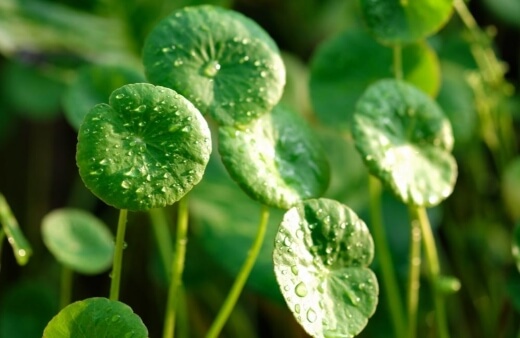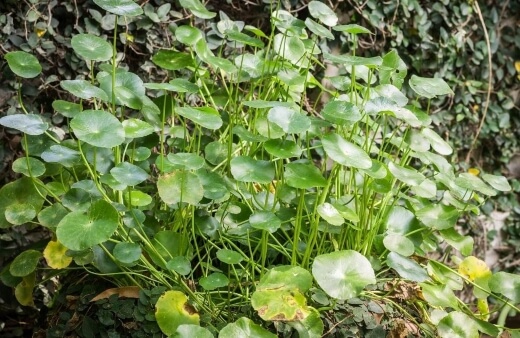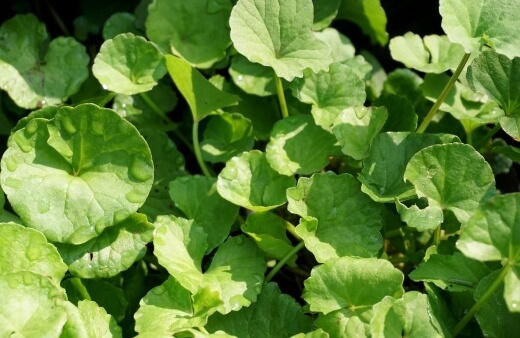One of our most revered native medicinal herbs and culinary vegetables is the luscious Pennywort. This herbaceous perennial flowering plant features slender creeping stems, round to heart-shaped lime-green leaves and a relaxed sprawling form, making it a great option for anyone looking to establish lush groundcover or a water plant in their landscapes.
It is perfect for moist positions under a well-watered tree or shallow-water positions like in and around rockeries. It is a low-maintenance addition to the garden widely famous for its bush tucker qualities.
Here is everything you need to know to grow and care for the pennywort plant.
More...

Family: | Apiaceae |
|---|---|
Genus: | Centella |
Species: | C. asiatica |
Common Names: | Pennywort, Gotu kola, Swamp pennywort |
Location: | Outdoor |
Type: | Vining plant, herb |
Growth: | 15 to 20 centimetres tall, 20 to 30 centimetres wide |
Sun requirements: | Full sun to light shade |
Foliage Colour: | Green |
Flower Colour: | White |
Flowering: | Spring to summer |
Maintenance level: | Low |
Poisonous for pets: | Non-toxic to cats and dogs |
The perky green leaves can add a lush and attractive appeal to any outdoor space. Despite how delicate the plant may appear, it has a tough nature and can quickly help to suppress weeds in your landscape.
It doesn’t like foot traffic so it’s not a good lawn alternative but is rather famed for its bush medicine qualities. Thanks to its spreading and sprawling form, it can be used for a few functional applications and its nutritious leaves can offer some unique culinary applications as well.
Getting to Know Pennywort
Centella asiatica or pennywort is now also commonly known as gotu kola or swamp pennywort. It is native to North and South America, Asia and Australia where it largely occurs in swampy regions of North Queensland and South Western Australia.
Part of the Apiaceae family, it thrives in temperate to tropical climates where crops mature in only 3 months. The entire plant with the roots is manually harvested for its medicinal and culinary applications.

Centella asiatica Growing Habits
This fast-growing plant normally reaches about 15 to 20 centimetres tall and 20 to 30 centimetres wide in cultivation. It’s good to know that it is considered an invasive species in some parts of the world as it spreads quickly if given the opportunity.
Pennywort is commonly planted in moist sites between pond-friendly rocks in shallow waters or potted in wide containers where it will form runners. It also makes for excellent groundcover.
How to Grow Pennywort in Australia
This plant is best grown by propagating and dividing established clumps of a mature plant or by transplanting a young and healthy nursery plant.

Nursery plants are readily available online or in-store and offer a much faster establishment time, meaning you can take advantage of this plant’s excellent properties sooner. Alternatively, division is a reliable method of propagation.
Propagating Gotu Kola Using Division
- Gently lift a section of an established plant from the ground using a spade or shovel.
- Then, cut a few clumps including the roots from the plant.
- Prepare wide propagation containers or a garden bed with well-draining soil and enrich with some compost or other organic matter.
- Water the soil lightly before planting then gently place the roots into the mixture.
- Plant the roots crown-deep into the soil and lightly cover with your mix.
- Water lightly after planting and keep the soil moist while the divided clumps establish new roots.
- You should have a reinvigorated and growing plant in no time.
Planting Nursery Plants
- Nursery plants should be ready for transplanting immediately so long as they are actively growing.
- You can simply place the potted nursery plant into shallow water or a dug-out section in your beds and it will continue its spread from there.
- If placed into a bed, enrich the area with some compost before planting.
- Water young nursery plants well as they develop.
Best Conditions for Planting Pennywort

This plant will need protection from frost so it’s best not to establish outdoors in cold climates. For dense coverage, plant specimens 30 centimetres apart in prepared beds.
If you intend on positioning as a water plant or near water, be sure that water is clean and away from dirty runoff as these plants will soak up harmful chemicals which can damage them.
Lighting Needs
Full sun to light shade is preferred. Full sun will force the leaves to hug the ground whereas light shade will cause them to stand upright.


Get Your Free Guide:
Master Growing Australian Natives eBook
A Must Have Complete Guide for Every Australian Garden
Get Your Free Guide:
Master Growing Australian Natives eBook
A Must Have Complete Guide for Every Australian Garden
Soil for Planting Pennywort
Pennywort can be grown in most soil types as long as the soil retains good moisture. Potting soil will work great for container-grown plants whereas sandy-loam soil or even clay mixed with perlite can work for garden plants.
It is good to note that these plants can also be grown exclusively in water as floaters.
Watering Routine
Potted or garden plants will thrive with moderate watering, especially after planting. Water more often during and towards the end of dry, hot summers when the plant begins to wilt.
Pruning
This plant requires no pruning.
Fertilising Gotu Kola
Feed with a balanced slow-release fertiliser regularly throughout the year as needed to encourage growth. (See this Liquid Potash Fruit & Flower Booster for reference).
Pennywort Bush Tucker Guide

Known as a ‘pharmacy in one herb’, pennywort truly offers some amazing benefits with its complex profile. The leaves are predominantly consumed for their highly nutritious properties but the stems and roots can also be used.
The fruits should not be eaten as they have a very bitter taste and don’t offer many benefits. The plant should not be consumed for extended periods in large quantities as it can have adverse effects on liver function.
Traditionally, the leaves were used to treat arthritis and rheumatism as well as many other general health issues. Here are some of the wonderful benefits of consuming pennywort:
- It has excellent anti-inflammatory properties.
- Can help to improve blood circulation and strengthen blood vessels.
- High in vitamin A, B, C and D.
- Contains minerals like magnesium, phosphorus, sodium, potassium and zinc.
- Works excellently for arthritis if 2 leaves are consumed per day.
Here is how you can use pennywort in the kitchen:
- Raw leaves can be used fresh in salads or added to dishes like curries, vegetarian dishes or fish dishes.
- Raw leaves are bitter whereas blanched leaves do tend to taste better.
- You can add some lemon juice and butter to massively improve the flavour of the leaves.
- Leaves can be stir-fried into meals or added to health drinks.
- Leaves can be infused as teas or tonics which can help to promote general health.
Here are some popular and nutritious recipes found online to help you get started:
Common Gotu Kola Pests & Diseases
There are few reported pest and disease issues with this tough native. However, when grown in gardens, the usual pests can become an issue.
Mealybugs & Spider Mites
These common garden pests should be dealt with as soon as you notice an infestation. They will usually appear on the undersides of leaves and in and around the stems.
They can appear as little leaf spots and will slowly consume the plant. To treat them, be sure to use a high-quality insecticidal spray or neem oil spray.
Be sure to stick with organic options, especially if you’ll be consuming the foliage eventually. Lightly spray your plant every few weeks to rid the plant of infestation. Water well after treatment.
Pennywort Frequently Asked Questions

Is pennywort invasive in Australia?
Floating specimens can become invasive aquatic plants. They cause serious issues in the UK and Northern Europe where they can flush out natives and impact fishing communities. However, cultivated plants in Australia don’t tend to become invasive in any way.
Which pennywort is edible?
Centella asiatica and Centella cordifolia are both excellent options for edible pennywort species in Australia. The stems, leaves and roots are all edible and offer many health benefits.
What does pennywort taste like?
When mixed into drinks, it will add a grassy aroma which can become overwhelming in large quantities. Juices can taste more like asparagus but if eaten fresh, the leaves and stems have a highly bitter flavour profile.
Does gotu kola raise blood pressure?
The plant has no significant effects on mood, heart rate or blood pressure and is safe to consume in controlled quantities.
Interested in establishing other excellent edible plants and flowers in your garden? Be sure to have a look at our extensive guide below:
Prop Up Your Garden's Lusciousness with Pennywort
With so many handy applications within landscapes and offering some of our best native herb properties, this decorative spreading plant is perfect for any grower looking for a lush groundcover or a fantastic water plant for their rockeries.
These plants are accessible to anyone and will establish themselves fast, meaning you and your family can take advantage of the excellent health benefits this plant offers very quickly.
Prop up your garden’s spectacle with this beloved bush tucker, Pennywort.
Published on August 11, 2022 by Lorri Hopkins
Last Updated on January 29, 2025




